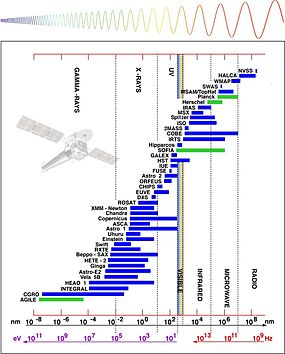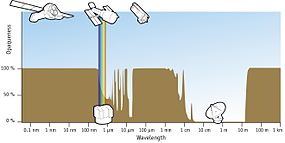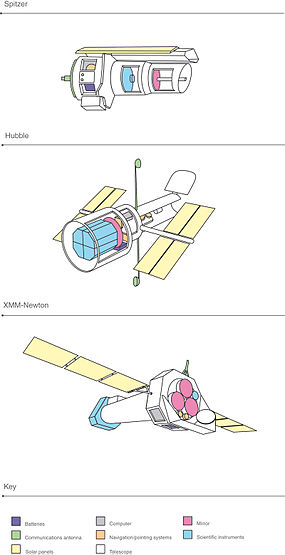- Space observatory
-
Space observatories 
Space observatories and their wavelength working rangesWebsite http://nssdc.gsfc.nasa.gov/astro/astrolist.html  Space observatories and their wavelength working range. Inspired by http://www.spitzer.caltech.edu/Media/mediaimages/background.shtml
Space observatories and their wavelength working range. Inspired by http://www.spitzer.caltech.edu/Media/mediaimages/background.shtml
A space observatory is any instrument (such as a telescope) in outer space which is used for observation of distant planets, galaxies, and other outer space objects. This category is distinct from other observatories located in space that are pointed toward the earth for the purpose of reconnaissance and other types of information gathering.
Contents
Introduction
A large number of observatories have been launched into orbit, and most of them have greatly enhanced our knowledge of the extraterrestrial universe.
Performing astronomy from the Earth's surface is limited by the filtering and distortion of electromagnetic radiation (scintillation or twinkling) due to the Earth's atmosphere. Some terrestrial telescopes (such as the Very Large Telescope) can reduce atmospheric effects with adaptive optics. A telescope orbiting the Earth outside the atmosphere is subject neither to twinkling nor to light pollution from artificial light sources on the Earth.
Space-based astronomy is even more important for frequency ranges which are outside of the optical window and the radio window, the only two wavelength ranges of the electromagnetic spectrum that are not severely attenuated by the atmosphere. For example, X-ray astronomy is nearly impossible when done from the Earth, and has reached its current importance in astronomy only due to orbiting X-ray telescopes such as the Chandra observatory and the XMM-Newton observatory. Infrared and ultraviolet are also greatly blocked.
Space observatories can generally be divided into two classes: missions which map the entire sky (surveys), and observatories which make observations of chosen parts of the sky.
Many space observatories have already completed their missions, while others continue operating, and still others are planned for the future. Satellites have been launched and operated by NASA, ESA, Japanese Space Agency and the Soviet space program later succeeded by Roskosmos of Russia.
History
In 1946, American theoretical astrophysicist Lyman Spitzer was the first to conceive the idea of a telescope in outer space, a decade before the Soviet Union launched the first satellite, Sputnik. Spitzer's proposal called for a large telescope that would not be hindered by Earth's atmosphere.[1] After lobbying in the 1960s and 70s for such a system to be built, Spitzer's vision ultimately materialized into the world's first space-based optical telescope, Hubble Space Telescope, which was launched on April 20, 1990 by the Space Shuttle Discovery (STS-31).[2][3]
See also
- Observatory
- Earth observation satellite
- Timeline of artificial satellites and space probes
- Timeline of telescopes, observatories, and observing technology
- List of space telescopes
- List of telescope types
References
- ^ "Hubble Essentials: About Lyman Spitzer, Jr.". Hubble Site. http://hubblesite.org/the_telescope/hubble_essentials/lyman_spitzer.php.
- ^ "Hubble Essentials: Quick Facts". Hubble Site. http://hubblesite.org/the_telescope/hubble_essentials/quick_facts.php.
- ^ "The Hubble Space Telescope". Vic Stathopoulos. http://www.aerospaceguide.net/hubblespacetelescope.html.
Space observatories Current Planned Nano-JASMINE · Astrosat (2012) · NuSTAR (2012) · Hard X-ray Modulation Telescope (HXMT) (2012) · GAIA (2013) · Spectrum-X-Gamma (2013) · Astro-G (2013+) · James Webb Space Telescope (JWST)
Proposals ATHENA · ATLAST · EChO · Euclid · LOFT · Fresnel Imager · New Worlds Mission · NGO · PLATO · SPICA · THEIA · WFIRST
Completed Akari (Astro-F) (2006-2011) · ALEXIS (1993-2005) · ASCA (Astro-D) (1993-2000) · Astro-1 (BBXRT · HUT) (1990) · Astro-2 (HUT) (1995) · Astron (1983-1989) · Astronomical Netherlands Satellite (1974-1976) · ATM (1973-1974) · BeppoSAX (1996-2003) · CHIPSat (2003-2008) · Compton Gamma Ray Observatory (1991-2000) · Cos-B (1975-1982) · COBE (1989-1993) · EPOCh (2008) · EXOSAT (1983-1986) · EUVE (1992-2001) · FUSE (1999-2007) · Ginga (1987-1991) · Granat (1989-1998) · Hakucho (1979-1985) · HALCA (1997-2005) · HEAO-1 (1977-1979) · HEAO-2 (Einstein Observatory) (1978-1982) · HEAO-3 (1979-1981) · HETE-2 (2000-2007?) · Hipparcos (1989-1993) · International Ultraviolet Explorer (1978-1996) · IRAS (1983) · ISO (1996-1998) · LEGRI (1997-2002) · MSX (1996-1997) · OAO-2 (1968-1973) · OAO-3 (Copernicus) (1972-1981) · Orion 1/2 (1971/1973) · RELIKT-1 (1983-1984) · ROSAT (1990-1999) · SAS-B (1972-1973) · SAS-C (1975-1979) · Tenma (1983-1985) · Uhuru (1970-1973) · WMAP (2001-2010) · Yohkoh (1991-2001)
Lost Completed On hiatus TAUVEX (2011)
Old plans Constellation-X · Darwin · Destiny · Eddington · FAME · IXO · JDEM · LISA · SIM & SIMlite · SNAP · TESS · TPF · XEUS
See also Great Observatories program · List of space telescopes · Sun spacecraft
Categories:- Astronomical observatories
- Space telescopes
- Observational astronomy
Wikimedia Foundation. 2010.

